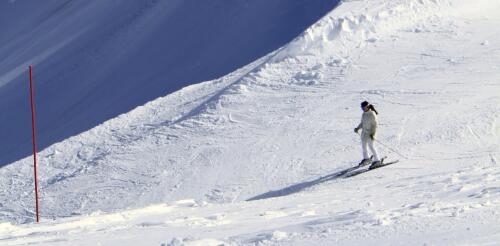Physics
Antarctica’s Thwaites Glacier got its nickname the “Doomsday Glacier” for its potential to flood coastlines around the world if it collapsed. It is already contributing about 4% of annual sea-level rise as it loses ice, and one theory suggests the glacier could soon begin to collapse into the ocean like a row of dominoes. But is that kind of rapid collapse really as likely as feared? A new study of Thwaites Glacier’s susceptibility to what’s known as marine ice cliff instability offers some hope. But the findings don’t mean Thwaites is stable. Polar scientist Mathieu Morlighem, who led the study, explains the results. Why is the Thwaites Glacier so important? Thwaites Glacier drains a huge area of Antarctica’s ice sheet – about 74,000 square miles (192,000 square kilometers), an expanse bigger than Florida. If a snowflake falls within that drainage system, it will eventually end up as part of an iceberg in the ocean off Thwaites....
An avalanche swept up skiers at Lake Tahoe’s largest ski resort on Jan. 10, 2024, as a 150-foot-wide sheet of snow slid down a mountain slope into a pile 10 feet deep. One person died in the avalanche and three others were rescued, according to the Placer County, California, Sheriff’s Office. The slide happened in steep terrain near the KT-22 chairlift, which had just opened for the season that morning. A second unplanned avalanche hit the same ski resort the next day, but no one was injured. Avalanche deaths are rare inbounds at ski resorts like Palisades Tahoe, but the risk rises in the backcountry – 30 backcountry avalanche deaths were reported in the U.S. during the 2022-2023 season. Nathalie Vriend, a skier and physicist at the University of Colorado Boulder who studies avalanches, explains what happens in an avalanche and techniques for surviving one. What causes avalanches? The behavior of an avalanche depends on the structure of the snowpack, but that...
Curious Kids is a series for children of all ages. If you have a question you’d like an expert to answer, send it to curiouskidsus@theconversation.com. Can rainbows form in a circle? – Henry D., age 7, Cambridge, Massachusetts The legend goes that there is a pot of gold hidden at the end of every rainbow. But is there really an “end” to a rainbow, and can we ever get to it? Most us go through life seeing rainbows only as arches of color in the sky, but that’s only half of what is really a circle of color. Normally, when you look at a rainbow, the Earth’s horizon in front of you hides the bottom half of the circle. But if you are standing on a mountain where you can see both above and below you, and the sun is behind you and it is misty or has just rained, chances are good that you will see more of the rainbow’s circle....
Home runs are exhilarating – those lofting moments when everyone looks skyward, baseball players and fans alike, anxiously awaiting the outcome: run or out, win or loss, elation or despair. Over the past several Major League Baseball seasons, home run numbers have climbed dramatically, including Aaron Judge’s record-breaking 62 homers for the New York Yankees in 2022. Baseball analysts have pointed to many different factors for this surge, from changes in baseball construction to advances in game analytics. Our study, published April 7, 2023, offers solid evidence for another cause – rising global temperatures. What we learned from 100,000 baseball games The physics tell a simple and compelling story: Warm air is less dense than cool air. As air heats up and molecules move faster, the air expands, leaving more space between molecules. As a result, a batted ball should fly farther on a warmer day than it would on a cooler day owing to less air resistance. Th...



